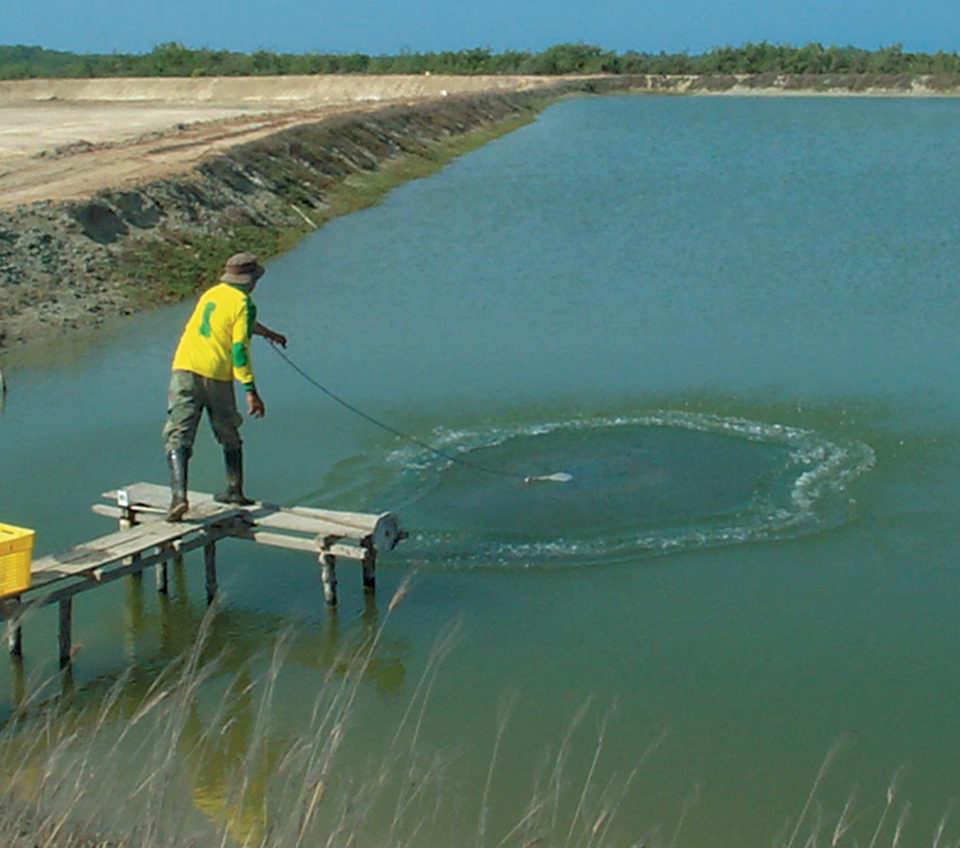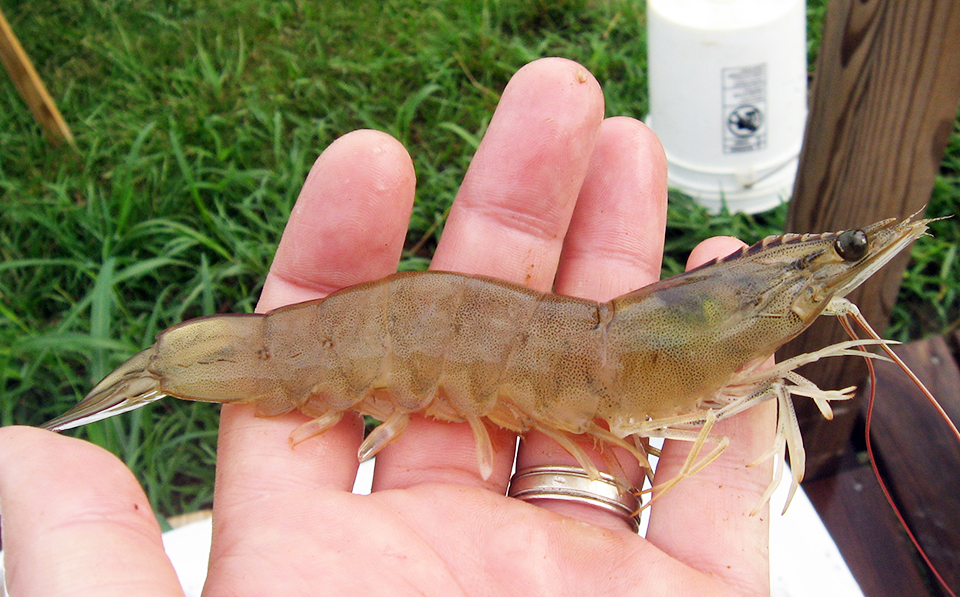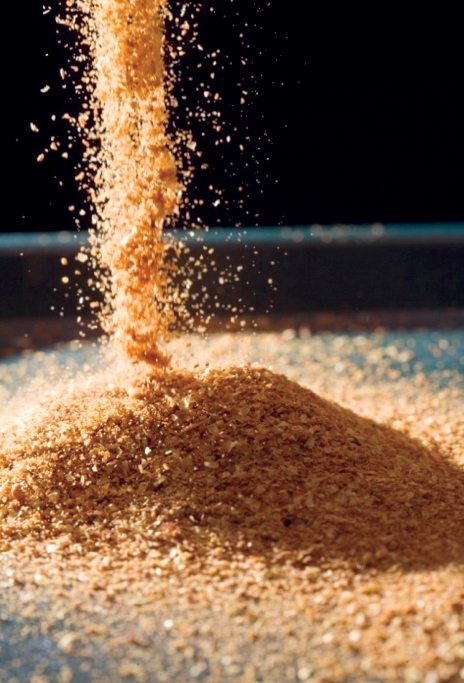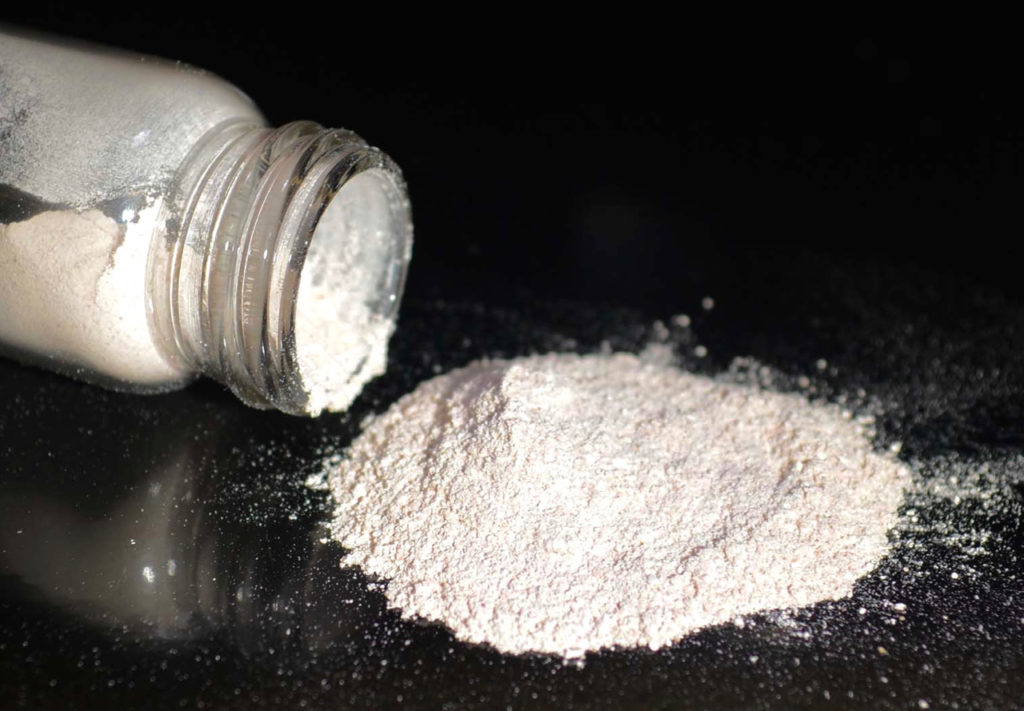Demonstrations resulted in feed cost reductions

For shrimp farmers, feed is one of the primary factors influencing the cost efficiency of shrimp farms. One way to improve production economics is to improve the consistency, quality and cost of the feed used at the farm level.
Shrimp farming has been the subject of controversial debates concerning, among other issues, the use of fishmeal in shrimp feeds. Hence, there are pressures to build both ecofriendly and profitable shrimp production systems.
Reducing fishmeal levels
A common approach to improving the cost effectiveness of feeds, as well as reducing their perceived impacts on the environment, is to remove or reduce the levels of fishmeal used. Given that fishmeal is one of the most costly and controversial ingredients, reducing its use could lower feed costs and improve the environmental image of the aquaculture industry.
In response to this challenge, shrimp nutrition research has steadily worked to define nutritional requirements as well as improve the quality and cost effectiveness of shrimp feeds. At the center of this work has been the reduction or removal of animal protein sources, as they are often costly and highly variable in terms of quality. Using alternative protein sources, primarily of plant origin, in balanced formulations has resulted in an improvement in the overall nutritional quality of practical diet formulations.
Numerous studies conducted under controlled laboratory conditions and in outdoor greenwater tank systems and experimental ponds have demonstrated the feasibility of replacing fishmeal with no adverse effect on the production performance of white shrimp (Litopenaeus vannamei). These trials have also demonstrated that diets with very minimal levels of marine products can be formulated in association with very high (58 percent diet) levels of soybean meal.
ASA-IM project
Based on these results, the next step is to gain commercial acceptance of the formulations. In order to promote the continued development of quality feed formulations, the American Soybean Association – International Marketing funded a project to transfer feed formulation technologies to the shrimp industry.
The project involved producers in Ecuador, Mexico and Colombia. These top producers of shrimp for the world market exported over 107,000 metric tons (MT) of shrimp to the United States during 2006, which represented over 18 percent of the total U.S. shrimp imports. The study was designed to provide technical assistance to both feed mills and shrimp farmers to allow them to test new formulations and benefit from technical assistance from specialists in the field.
Regional seminars
With that purpose in mind, regional seminars were conducted in each country to disseminate results obtained in research centers. These seminars led to the identification of producers and feed manufacturers willing to try new practices. This was a critical step, since farmers are often quite reluctant to change their practices and adopt new technologies.
The process started with the identification of feed mills and producers interested in evaluating modified feeds under their own production conditions. Shrimp farmers were asked to compare their traditional feeds against a feed with lower inclusion levels of fishmeal. The levels of inclusion were determined by the producers and feed manufacturer to make them feel more comfortable with the experiment.
Although closely controlling conditions in the real world can be difficult, farmers were asked to follow a protocol that included stocking of paired ponds that were similar in size, use of seed from the same origin and stocking under similar conditions. They were also encouraged to use their traditional feeding and culture procedures.
Field trials
Initial trials were conducted in Ecuador, Mexico and Colombia in mid- to late 2006. The fishmeal in the participants’ traditional feed formulations was reduced primarily by the addition soybean and corn gluten meal.
Ecuador
In Ecuador, the Bravo Grande shrimp farm and Inprosa feed mill started with a reduction in fishmeal content of 50 percent from their traditional formulation. Culture conditions (Table 1) were extensive, with a stocking density of 7.2 shrimp per square meter, pond sizes ranging 7.5 to 10.5 ha and a production cycle of 106 days.
Quintero, Summary of production cycle, Table 1
| S.A. | Bravo Grande Ecuador | Acuicola Polo Mexico | Acuacultivos El Guajaro Colombia |
|---|---|---|---|
| Stocking date | April 2006 | May 2006 | December 2006 |
| Cycle | 106 days | 185 days | 109-121 days |
| Stocking density | 7.2/m2 | 27.5/m2 | 36-42/m2 |
| Number of ponds | 4/treatment | 3/treatment | 2/treatment |
At the end of this study, the 1.09 grams per week growth rate, 16.54-gram average final weight of the shrimp and reduced feed-conversion ratio of 1.04 reflected improvements over the performance of the control ponds (Table 2). However, at 45.7 percent and 535 kg/ha, survival and pond yield were significantly lower than the control values.
Quintero, Production summary, Table 2
| Treatment | Survival (%) | Weight (g) | Growth (g/week) | Yield (kg/ha) | FCR | |
|---|---|---|---|---|---|---|
| Bravo Grande | 50% fishmeal reduction | 45.7 | 16.5 | 1.09 | 535 | 1.04 |
| Control | 58.9 | 15.6 | 0.92 | 657 | 1.14 | |
| Acuicola Polo | 50% fishmeal reduction | 72.3 | 18.1 | 0.68 | 2,665 | 2.50 |
| Control | 65.3 | 20.4 | 0.77 | 2,937 | 2.30 | |
| Acuacultivos El Guajaro S.A. | 75% reduction 50% reduction | 71.5 69.1 | 10.9 9.6 | 0.65 060 | 3.208 2,690 | 1.13 1.26 |
| Control | 72.1 | 9.9 | 0.59 | 2,941 | 1.14 |
These results encouraged the companies to do one more trial, which was also successful. Consequently, the entire farm is now using diets with reduced levels of fishmeal and increased levels of soybean meal.
Mexico
Trials in Mexico were run at Acuicola Polo, a shrimp farm located in the state of Sonora, with the support of Vimifos, a feed mill located near Obregon. The shrimp producer agreed to try a feed with 50 percent reduction of the usual levels of fishmeal. Culture conditions (Table 1) at this farm were semi-intensive with a stocking density of 27.5 shrimp per square meter and pond sizes of 1 ha. The production cycle was 185 days with partial harvests during the cycle.
Although shrimp survival rose to 72.3 percent on the reduced-fishmeal feed, other performance parameters – weekly growth rate, final shrimp weight and yield – slipped about 10 percent (Table 2). At 2.5, the feed conversion was also not ideal, demonstrating that diet efficiency is only part of the puzzle to improve production.
Colombia
In Colombia, Acuacultivos El Guajaro S.A., a farm located on the Atlantic Coast, worked with the assistance of Agrinal Colombia S.A., a feed mill with a plant in Cartagena. The trial was conducted in duplicate ponds with diets containing 50 and 75 percent reductions in fishmeal content as compared to traditional diets.
This farm raised its shrimp in a low-salinity environment and used a higher stocking density with 36 to 42 shrimp per square meter. Its production results were maintained at levels similar to those obtained with the farm’s traditional feed (Table 2). Average production was 2,950 kg/ha with 70.3 percent survival and FCR of 1.19 (Table 2). In the ponds that received feed with a 75 percent reduction in fishmeal, animal weight and growth, and overall yield were significantly higher than the values for the control ponds.
Effective replacement
Modifications of the feed formulations used in the demonstrations resulted in feed cost reductions and relatively few effects on production at the farm level. Hence, the replacement of fishmeal with a combination of soybean meal, corn gluten meal and other locally available protein sources was a viable way to reduce feed costs and improve feed quality at the farms.
By transferring feed formulation information as well as improved manufacturing practices to the feed mill, the quality and cost of shrimp feeds were improved. Although quality feed was supplied to all the producers, the poor feed conversion at some sites demonstrated that feed quality is only part of the equation. Feeding practices and general management can be further improved at some sites.
(Editor’s Note: This article was originally published in the November/December 2008 print edition of the Global Aquaculture Advocate.)
Now that you've reached the end of the article ...
… please consider supporting GSA’s mission to advance responsible seafood practices through education, advocacy and third-party assurances. The Advocate aims to document the evolution of responsible seafood practices and share the expansive knowledge of our vast network of contributors.
By becoming a Global Seafood Alliance member, you’re ensuring that all of the pre-competitive work we do through member benefits, resources and events can continue. Individual membership costs just $50 a year.
Not a GSA member? Join us.
Authors
-
Herbert E. Quintero, Ph.D.
Department of Fisheries and Allied Aquacultures
203 Swingle Hall
Auburn University
Auburn Alabama 36849-5419 USA -
D. Allen Davis, Ph.D.
Department of Fisheries and Allied Aquacultures
203 Swingle Hall
Auburn University
Auburn Alabama 36849-5419 USA[117,100,101,46,110,114,117,98,117,97,64,97,100,115,105,118,97,100]
Tagged With
Related Posts

Aquafeeds
Alternatives to fishmeal perform well in low-salinity shrimp farm trial
In a white shrimp farm trial in a low-salinity environment, alternatives to fishmeal did not negatively impact the growth, survival or FCR of the shrimp.

Aquafeeds
A look at corn distillers dried grains with solubles
Corn distillers dried grains with solubles are an economical source of energy, protein and digestible phosphorus to reduce feed costs and fishmeal usage.

Aquafeeds
A look at protease enzymes in crustacean nutrition
Food digestion involves digestive enzymes to break down polymeric macromolecules and facilitate nutrient absorption. Enzyme supplementation in aquafeeds is a major alternative to improve feed quality and nutrient digestibility, gut health, compensate digestive enzymes when needed, and may also improve immune responses.

Aquafeeds
A new nutrient for aquaculture, from microbes that consume carbon waste
Biotechnology firm NovoNutrients aims to produce a line of nutraceutical aquafeed additives as well as a bulk feed ingredient that can supplement fishmeal. Its process includes feeding carbon dioxide from industrial gas to a “microbial consortium” starring hydrogen-oxidizing bacteria.


